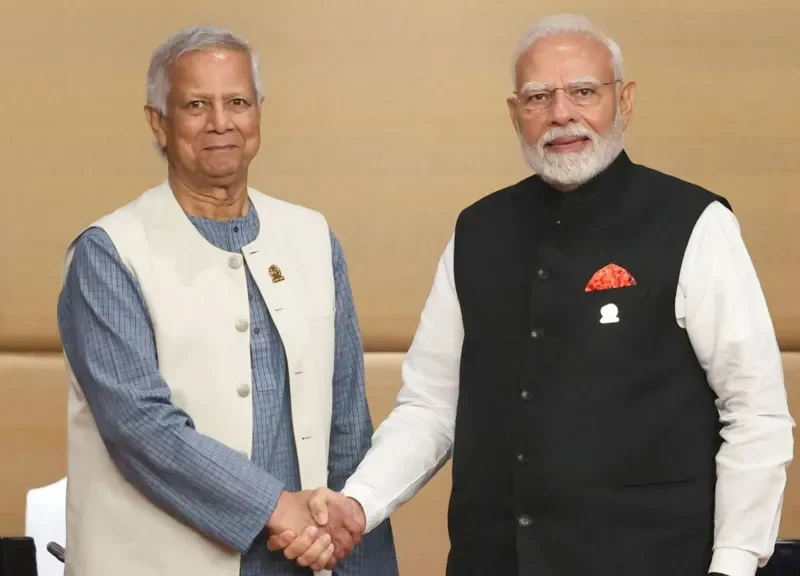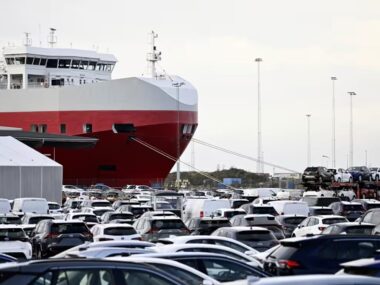Businesses are preparing for potential fallout as India and Bangladesh implement retaliatory trade restrictions following months of diplomatic tensions.
In a move to protect domestic producers, Bangladesh recently curbed land imports of cotton yarn from India, citing concerns over low-cost competition. This followed India’s sudden suspension of a transshipment arrangement that allowed Bangladeshi goods to be exported to third countries through Indian ports and airports, which it blamed on “congestion.”
Tensions between the two countries have escalated since the ousting of former Bangladeshi Prime Minister Sheikh Hasina in August after widespread protests. Currently in exile in India, Hasina faces demands from the interim Bangladeshi government—led by Nobel laureate Muhammad Yunus—for her extradition on charges including corruption and crimes against humanity. She denies all allegations, and India has yet to officially respond.
Adding to the strain, India has condemned what it describes as recurring attacks on Bangladesh’s Hindu minority, highlighting a recent case involving the alleged murder of a Hindu leader as evidence of systematic persecution. Dhaka has rejected these claims, stating that such incidents are either politically charged or ordinary crimes. Hindus represent less than 10% of Bangladesh’s 170 million citizens.

Bangladesh has limited the import of Indian cotton through land routes.
As tensions escalate between India and Bangladesh, businesses are weighing the financial consequences.
Although cotton yarn—a key input for Bangladesh’s garment sector—can still be brought in by sea and air, these alternatives are slower and more expensive. In 2024, India exported $1.6 billion worth of cotton yarn to Bangladesh, with about one-third transported through land routes now restricted.
India’s suspension of a transshipment facility, previously used by Bangladesh to send garments for global brands via Indian cities to Europe and the U.S., has dealt a significant blow to the country’s fast-fashion exports. According to Anis Ahmed of MGH Group, which handles shipments for brands like Zara, land-air routes via India could deliver goods to the West in a week, compared to up to eight weeks by sea.
Bangladesh, the world’s second-largest apparel exporter after China, shipped $38 billion worth of garments last year. Over $1 billion of that used the Indian land-air channel, a route Ahmed says had become crucial due to Bangladesh’s limited air freight capacity and outdated airport infrastructure.
The timing of India’s move has sparked speculation. Some view it as a reaction to recent remarks by interim Bangladeshi leader Muhammad Yunus during a visit to China. Yunus referred to Bangladesh as the “only guardian of the ocean” for India’s landlocked northeast and hinted the region could become a “Chinese economic extension”—a comment that provoked backlash in India’s northeast and raised strategic concerns in Delhi.
India’s northeast is connected to the rest of the country via the narrow 20-kilometre Siliguri Corridor—bordered by Nepal, Bangladesh, and near China’s Tibet—making it a critical vulnerability. With past military tensions, including the 1962 war with China, Indian defence planners worry about potential threats to this chokepoint.
While Bangladeshi experts say Yunus’s comments were misunderstood and aimed at encouraging connectivity, Delhi’s unease grew further after Dhaka welcomed Chinese investment in a $1 billion Teesta River development project near the sensitive corridor. Indian strategists caution that deeper Chinese involvement in the area could disrupt regional balance.

Bangladesh ranks as the second-largest global exporter of ready-made garments.
Tensions between India and Bangladesh are deepening, sparking concern on both sides about the state of their bilateral relationship.
In Bangladesh, frustration is mounting over India’s stricter visa policies, with approvals reportedly falling by more than 80% since Sheikh Hasina’s removal from office. Previously, around two million Bangladeshis visited India each year for tourism, business, education, and healthcare.
The continued presence of Hasina in India and Bangladesh’s demand for her extradition remain key points of friction. Former Indian foreign secretary Shyam Saran stated that handing her over is not a viable option, citing concerns over her safety and public backlash in India.
As the diplomatic climate deteriorates, India’s clothing manufacturers are now urging a ban on garment imports from Bangladesh via land routes. In response, Bangladeshi analysts are warning that additional trade restrictions would backfire. Economist Debapriya Bhattacharya has suggested re-evaluating the transit and transshipment privileges India enjoys through Bangladesh to access its northeast, benefits initially granted under Hasina’s leadership. Although India relies on Bangladeshi ports, roads, and waterways for cost-efficient logistics, officials note that transit activity remains below expectations.
Strains are also emerging over Bangladesh’s warming ties with Pakistan. After years of minimal engagement during Hasina’s 15-year rule, Pakistan’s Foreign Secretary Amna Baloch recently visited Dhaka—the first such trip in 15 years. However, a scheduled visit by Pakistan’s Deputy PM was postponed amid fresh hostilities between India and Pakistan over a deadly attack in Kashmir.
Saran downplayed concerns over Bangladesh reconnecting with Pakistan but warned that any coordinated action against India would raise alarms in Delhi.
Amid this backdrop, harsh rhetoric and government actions are influencing public perception in both countries. Anti-India sentiment appears to be growing in Bangladesh, where Indian media is accused of overstating attacks on minorities and Islamist threats. Analysts caution that deteriorating people-to-people ties could undermine longstanding trade and economic cooperation if both nations fail to de-escalate.











